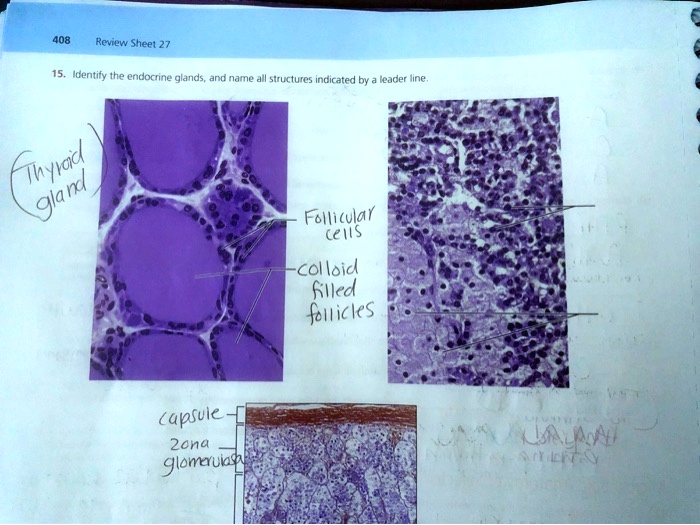Functional anatomy of the endocrine glands review sheet – Unveiling the Functional Anatomy of the Endocrine Glands: Delving into the intricate interplay of hormones and their profound impact on our physiological processes.
This review sheet embarks on an enlightening journey through the fascinating realm of endocrinology, exploring the structural and functional aspects of the endocrine glands, the maestros of hormone production and regulation. Prepare to unravel the complexities of these enigmatic glands and their pivotal role in maintaining the body’s delicate balance.
Define the Endocrine System
The endocrine system is a complex network of glands that produce and secrete hormones into the bloodstream. Hormones are chemical messengers that travel throughout the body, regulating various physiological processes, including metabolism, growth, reproduction, and homeostasis.
The endocrine system works in conjunction with the nervous system to maintain the body’s internal balance and respond to external stimuli.
Discuss the Functional Anatomy of the Endocrine Glands: Functional Anatomy Of The Endocrine Glands Review Sheet

Structure and Organization of Endocrine Glands
Endocrine glands are typically composed of specialized cells that secrete hormones into the bloodstream. These cells are organized into either:
- Follicles: Spherical clusters of cells that surround a central cavity
- Cords: Strands of cells arranged in parallel rows
The glands are surrounded by a capsule of connective tissue that provides structural support and contains blood vessels for hormone transport.
Histological Features of Endocrine Glands
Endocrine glands have several histological features that distinguish them from other tissues:
- Lack of ducts: Endocrine glands do not have ducts to transport their secretions; hormones are released directly into the bloodstream.
- Abundant blood supply: The glands are highly vascularized to facilitate the transport of hormones throughout the body.
- Large nuclei and prominent nucleoli: These features indicate active protein synthesis, which is necessary for hormone production.
Describe the Major Endocrine Glands

Pituitary Gland
The pituitary gland, located at the base of the brain, is often referred to as the “master gland” because it controls the activity of other endocrine glands.
The pituitary gland consists of two lobes: the anterior pituitary and the posterior pituitary. The anterior pituitary produces hormones that regulate growth, metabolism, and reproduction, while the posterior pituitary stores and releases hormones produced by the hypothalamus.
Thyroid Gland, Functional anatomy of the endocrine glands review sheet
The thyroid gland, located in the neck, produces hormones that regulate metabolism, growth, and development.
The thyroid gland produces two main hormones: thyroxine (T4) and triiodothyronine (T3). These hormones are essential for proper growth and development, as well as for maintaining a healthy metabolism.
Parathyroid Glands
The parathyroid glands, located near the thyroid gland, produce parathyroid hormone (PTH).
PTH regulates calcium and phosphate levels in the blood, ensuring proper bone formation and muscle function.
Adrenal Glands
The adrenal glands, located on top of the kidneys, produce a variety of hormones, including cortisol, adrenaline, and aldosterone.
These hormones play a role in regulating stress responses, blood pressure, and electrolyte balance.
Pancreas
The pancreas, located behind the stomach, produces insulin and glucagon.
Insulin and glucagon regulate blood sugar levels, ensuring proper energy metabolism.
Pineal Gland
The pineal gland, located deep within the brain, produces melatonin.
Melatonin regulates the body’s circadian rhythm, which helps to control sleep-wake cycles.
Explain the Regulation of Hormone Secretion

Hormone secretion is regulated by various mechanisms, including:
Negative Feedback Loops
Negative feedback loops are the most common mechanism for regulating hormone secretion. In a negative feedback loop, the hormone itself inhibits its own production.
For example, when blood sugar levels rise, the pancreas releases insulin. Insulin lowers blood sugar levels, which in turn signals the pancreas to stop releasing insulin.
Positive Feedback Loops
Positive feedback loops are less common than negative feedback loops. In a positive feedback loop, the hormone stimulates its own production.
For example, during childbirth, oxytocin stimulates the release of more oxytocin, which leads to stronger uterine contractions.
Discuss the Clinical Significance of the Endocrine System

Impact of Endocrine Disorders on the Body
Endocrine disorders can have a wide range of effects on the body, including:
- Metabolic disorders, such as diabetes and obesity
- Growth disorders, such as gigantism and dwarfism
- Reproductive disorders, such as infertility and menstrual irregularities
- Bone disorders, such as osteoporosis and Paget’s disease
- Mood disorders, such as depression and anxiety
Common Endocrine Disorders
Some of the most common endocrine disorders include:
- Diabetes mellitus
- Thyroid disorders
- Cushing’s syndrome
- Addison’s disease
- Polycystic ovary syndrome
Diagnostic and Treatment Approaches for Endocrine Disorders
The diagnosis of endocrine disorders typically involves a combination of physical examination, blood tests, and imaging studies.
Treatment for endocrine disorders varies depending on the specific disorder and its severity. Treatment options may include:
- Medication
- Surgery
- Lifestyle changes
FAQ Insights
What is the primary function of the endocrine system?
The endocrine system is responsible for regulating various physiological processes through the secretion of hormones, which act as chemical messengers coordinating functions throughout the body.
How do endocrine glands differ from exocrine glands?
Unlike exocrine glands, which release their secretions into ducts leading to specific organs, endocrine glands secrete hormones directly into the bloodstream, allowing them to reach target cells throughout the body.
What is the significance of feedback loops in hormone regulation?
Feedback loops play a crucial role in maintaining hormonal balance. Negative feedback loops ensure that hormone levels are kept within a narrow range by inhibiting further hormone secretion when levels rise, while positive feedback loops amplify hormone secretion in response to specific stimuli.